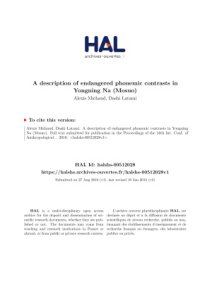
Ebook: A description of endangered phonemic contrasts in Yongning Na (Mosuo)
Author: Michaud Alexis Latami Dashi.
- Genre: Linguistics // Foreign
- Tags: Языки и языкознание, Лолойские языки
- Language: Lolo-English
- pdf
Full text submitted for publication in the Proceedings of the 16th Int. Conf. of Anthropological and Ethnological Sciences (ICAES 2009),
Academic Session on Issues of Language Endangerment. — 14 p.The investigation concerns phonemic contrasts (including tonal contrasts) that are under a severe danger of disappearing from the Na language spoken in the plain of Yongning (Ninglang prefecture, Lijiang municipality, Yunnan province, China). This language belongs to the Sino-Tibetan family; it is also known as “Mosuo” and “Yongning dialect of Eastern Naxi”. The overall tendency is, unsurprisingly, that the phonemic contrasts found in Mosuo but not in Mandarin Chinese tend to become lost by the speakers who are most proficient in Chinese. We discuss several examples in detail. Among other consonants, Na contrasts /l/, /ɬ/, /ʁ/, and /ɻ/; this set is fully preserved in the speech of a 55-year-old speaker, whereas in the speech of a schoolgirl (currently in senior high school) the four have simplified to /l/: /Mli/ “to look” and /Mɬi/“ear; moon” have both simplified to /li/; the syllables /ʁæ/ and /ɻæ/ in /Mʁæ.mi/“sword” and /#Hkʰwæ.ɻæ/ “satin” all simplified to /læ/. In-between these two extremes, in the speech of a speaker aged 35, these phonemic contrasts are preserved but their lexical distribution is becoming somewhat imperfect.
Academic Session on Issues of Language Endangerment. — 14 p.The investigation concerns phonemic contrasts (including tonal contrasts) that are under a severe danger of disappearing from the Na language spoken in the plain of Yongning (Ninglang prefecture, Lijiang municipality, Yunnan province, China). This language belongs to the Sino-Tibetan family; it is also known as “Mosuo” and “Yongning dialect of Eastern Naxi”. The overall tendency is, unsurprisingly, that the phonemic contrasts found in Mosuo but not in Mandarin Chinese tend to become lost by the speakers who are most proficient in Chinese. We discuss several examples in detail. Among other consonants, Na contrasts /l/, /ɬ/, /ʁ/, and /ɻ/; this set is fully preserved in the speech of a 55-year-old speaker, whereas in the speech of a schoolgirl (currently in senior high school) the four have simplified to /l/: /Mli/ “to look” and /Mɬi/“ear; moon” have both simplified to /li/; the syllables /ʁæ/ and /ɻæ/ in /Mʁæ.mi/“sword” and /#Hkʰwæ.ɻæ/ “satin” all simplified to /læ/. In-between these two extremes, in the speech of a speaker aged 35, these phonemic contrasts are preserved but their lexical distribution is becoming somewhat imperfect.
Download the book A description of endangered phonemic contrasts in Yongning Na (Mosuo) for free or read online
Continue reading on any device:

Last viewed books
Related books
{related-news}
Comments (0)